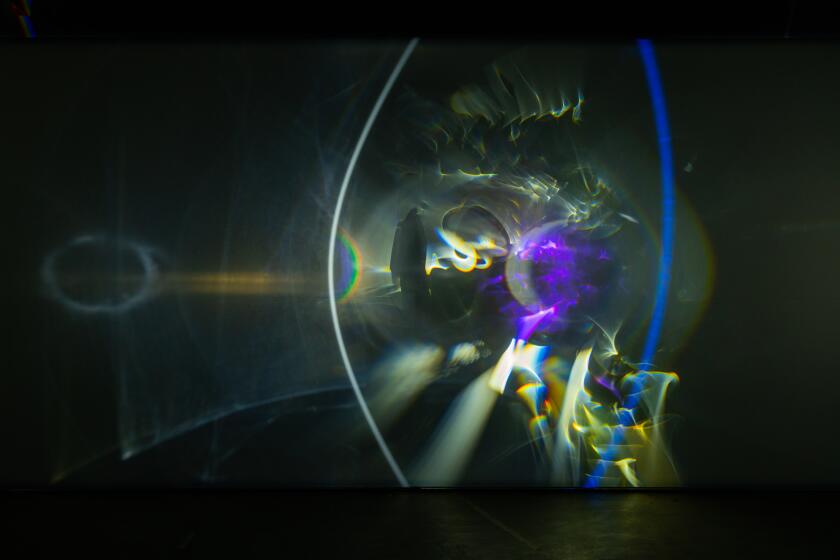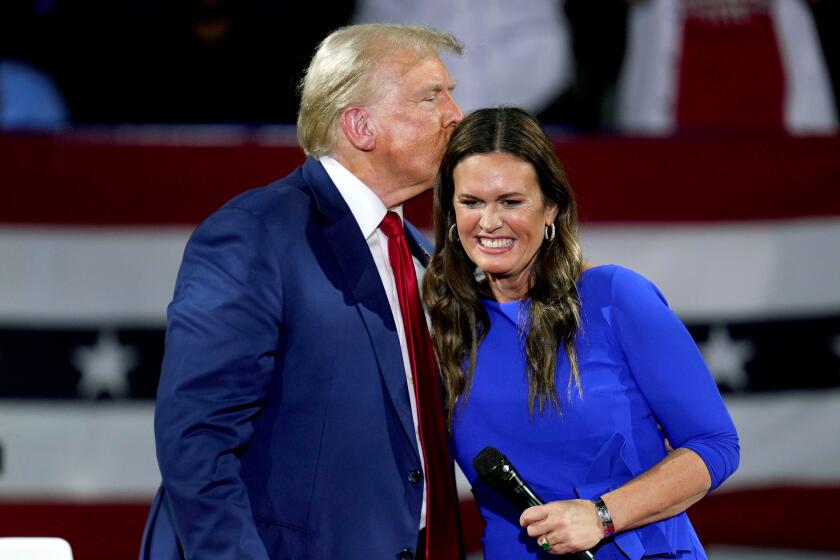Art meets war, and one loses
DESPERATE for cash, his dreams of an art career swept away by war, Nebil Anwar turned his knack with a paintbrush to producing portraits of U.S. soldiers’ wives and children.
It was hardly art, but it was a living. It also could have gotten him killed.
Men armed with Kalashnikovs and a radical faith are the law in many Baghdad neighborhoods, so even innocuous contact with U.S. forces is enough to be labeled a collaborator. Artists must smuggle their wares to their few remaining patrons.
It wasn’t supposed to be like this, said Anwar, who has since left Baghdad for Jordan. When Saddam Hussein’s statue was pulled down in Baghdad’s Paradise Square in April 2003, young artists were among the first to embrace the possibilities of a new era. Within weeks a new statue rose in its place. The abstract tribute to freedom stands there still, its garish green surface chipped, faded and pocked with what appear to be bullet holes.
Like other segments of Iraqi society, the art community is withering under a daily assault of car bombs, kidnappings, gunfights and mortar blasts. Dictatorship has given way to the suffocating strictures of religious extremists, who frown on most forms of artistic expression, consider sculpture idolatrous and a painting of a nude an insult to Islam.
Many of Iraq’s artists have joined the flight that has decimated the country’s intellectual reserves. For those who remain, it is a constant struggle to keep producing work that few will ever see and most cannot afford.
Anwar traces his love of painting to early childhood, when he would watch his sisters sketch in pencil. His older brother tried to steer him toward what he considered more manly pursuits. His fate was sealed when their father died, leaving the two brothers to support their mother, five sisters and another brother who was sickly.
Anwar joined Hussein’s air force and qualified as a pilot. It was a decision that would haunt him. After Hussein’s fall, when he finally got to pursue a master’s degree in fine arts, Shiite Muslim students started asking pointed questions about his past.
Pilots had been considered elite members of the military under Hussein and many former pilots have fallen victim to Shiite death squads. Anwar, a Kurd, lived in a Sunni Muslim neighborhood and was terrified the same would happen to him..
Anwar, who carries the shadows of many sleepless nights under his dark-brown eyes, says he was never interested in religion or politics. His passion was for the emotional sweep and luminous colors of America’s abstract expressionists.
“They make paintings like pure light,” he said in May, leafing through pictures of their works at a noisy cafe in the Jordanian capital, Amman.
But Anwar’s fellow students, and even some of his teachers, seemed preoccupied with currying favor with Iraq’s new leaders.
“All the exhibitions by students are about religion; that destroyed me,” he said, reaching for a pipe and pulling out a crumpled packet of tobacco.
“Before, it was all propaganda about the nation. Now it is propaganda about religion.”
He dropped out of college and tried to make a living selling paintings inspired by his city’s sandy, sun-bleached hues. After 10 months of penury, he gave up and started turning out portraits of Americans.
His renditions of wedding and baby photos were popular souvenirs among troops deployed in Iraq. A dealer with contacts inside the fortified Green Zone, where many foreigners live and work, brought him the snapshots to copy. Working secretly from a room in one of Baghdad’s most dangerous neighborhoods, Anwar could produce two or three paintings a day at $50 apiece, a small fortune in postwar Iraq.
But Anwar seemed to spend half his life peering over his shoulder. An unexpected knock on his studio door sent him into a panic. Finally, the pressure became too much to bear, and he fled to Jordan last year.
“Art will die in Iraq,” he predicted gloomily. “Art comes from the artists, and if the artists go, then art will go with them.”
DOYENS of the Middle East’s more stylish capitals may sneer at the bland Iraqi cuisine and frumpy dress sense. But since the ancient Sumerians began etching pictures in wet mud, giving birth to the world’s first script, the country dubbed the cradle of civilization has been revered as a center of art and culture.
The many civilizations that passed through Iraq left an imprint on its artists, from the winged bulls that guarded Assyrian city gates to the elegant calligraphy of Islamic art. Now those who inherited that proud tradition are scattered across the Middle East, Europe and the United States.
The exodus began during the U.N. embargo imposed after Iraq’s 1991 defeat in the Persian Gulf War. The local art market collapsed because no one had money for anything but essentials. Tourists no longer visited, and it became difficult for artists to exhibit their works abroad.
The U.S.-led March 2003 invasion briefly renewed interest in Iraq’s artists. Soldiers, aid workers, diplomats and journalists snapped up their works at tiny galleries dotted across the city. Now, most of those shops have closed, and their owners must bring the exhibitions to the dwindling pool of foreigners who can afford to buy a painting.
Abdullah Omar’s Al Meezan gallery and graphics studio, on a riverside street near major hotels, once held glittering openings patronized by foreign businessmen, United Nations representatives and embassy employees. Most of them have fled. The gallery was looted twice in the chaotic days after Hussein’s fall. Omar closed it after the street was blocked off with concrete barriers to protect it from regular bombings.
“It is like a haunted place,” said Omar, a large man with closely cropped hair who wears an embroidered shirt over khaki trousers. “The art is covered with dust and cobwebs.”
Omar ventures there only occasionally, to collect pieces to show his old clients when they pass through Baghdad. In the safety of their hotel rooms, he produces signed lithographs by the pioneering painter and curator Noori Rawi, and the late Ismail Fatah, who built Baghdad’s landmark Martyr’s Monument, a giant turquoise egg split in half to release the anguished souls of the dead.
Qasim Sabti, another gallery owner and painter, has managed to keep going through most of the post-invasion tumult. His Hewar gallery is a sanctuary for the city’s remaining artists, who continue to meet over cups of sweet tea in the leafy courtyard cafe. But organizing exhibitions is tough now, he says.
“The mullahs have no idea about art,” he said. “We are ready to do carnivals of theater, dancing, music.... But they hate these activities. So they promote militias and make the culture of death.”
SOME artists admit to nostalgia for Hussein’s reign. For all his brutish oppression, Hussein was a champion of the arts, through which he promoted his brand of Arab nationalism.
His regime bought up hundreds of works and sponsored competitions, international exhibitions and scholarships abroad.
Although there was no overt censorship, it was understood that producing works glorifying Hussein and his wars would secure commissions. Many artists did, but others did not. Provided they did not directly challenge Hussein, they were mostly left alone.
“During the Saddam regime, we knew where the red line was, and we could stop before crossing it,” Sabti said. “Now, there are a thousand red lines. We are stuck in one place, unable to move.”
For others, there is little difference between the terrors of dictatorship and the horrors of today’s violence.
“We were tortured then, and we are tortured now,” said Nidha Kadhim, a celebrated sculptor from the Shiite south. “It is the same thing.”
Kadhim’s brother was beheaded for fleeing Hussein’s army and trying to buy a fake ID. His act of defiance cast suspicion on the entire family, and Kadhim spent a year in prison.
Kadhim says he rarely works more than an hour a day, because Baghdad’s frequent power outages keep him from firing up his kiln to make his bronzes. Finding a model is also problematic. Asking a woman to whom he is not related to sit for him would be risking both their lives.
“This is one of the many things that keep us hidden behind concrete walls,” said Kadhim, a soft-spoken man with a bushy, gray beard and wild hair. “We don’t want to show our works. We don’t want to know anybody, and we don’t want anybody to know us.”
But there are a few who have not given up hope. When everyone else was closing last year, Hassan Nasar opened his Madarat gallery, not far from Hewar. Since then, he has offered a packed schedule of exhibitions, lectures and poetry readings.
Few of the artists make any money from the shows. Sometimes only a handful of visitors turn up. But in the words of one regular, the gallery is “the lung” that breathes life into the fading art community.
For Nasar, the gallery embodies his belief in the power of art to open the eyes of those who follow blindly; it restores sanity amid the bloodshed and creates new heroes for a generation growing up under the sway of gunmen.
“Art is part of life here in Iraq,” he said. “Without it, people would become like monsters.”
--
Zavis reported from Baghdad and Amman. Times staff writers Suhail Ahmad and Saad Khalaf in Baghdad contributed to this report.
More to Read
The biggest entertainment stories
Get our big stories about Hollywood, film, television, music, arts, culture and more right in your inbox as soon as they publish.
You may occasionally receive promotional content from the Los Angeles Times.










